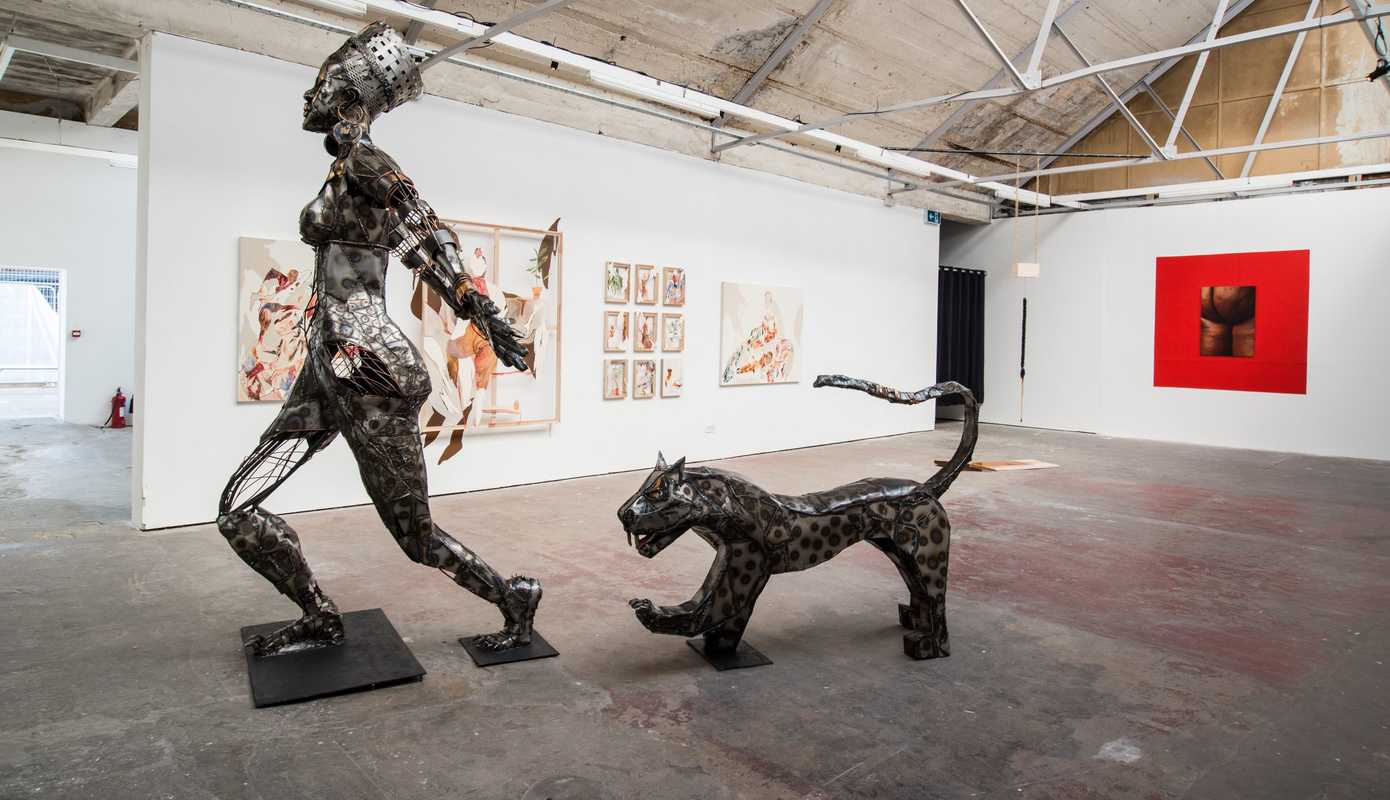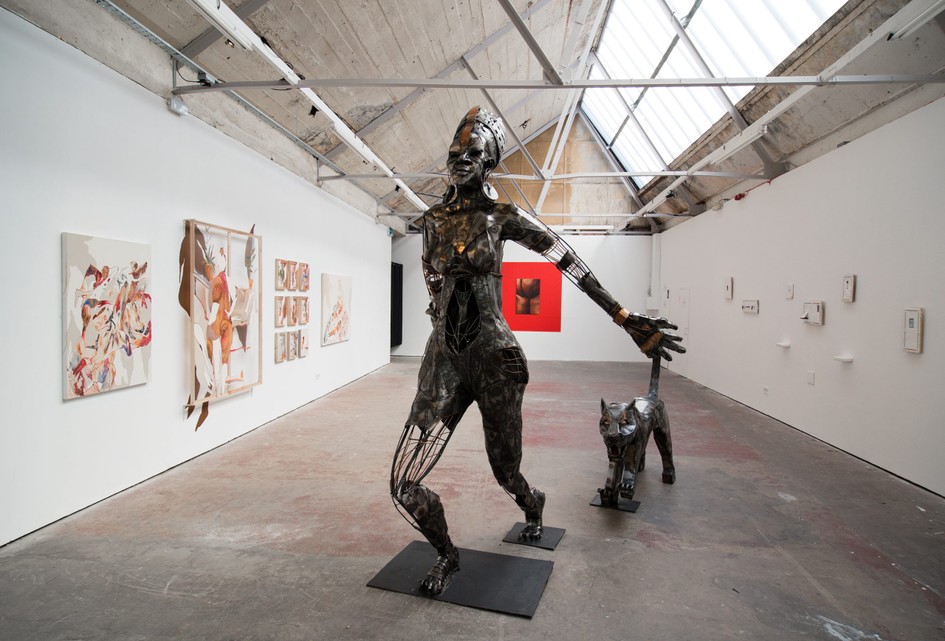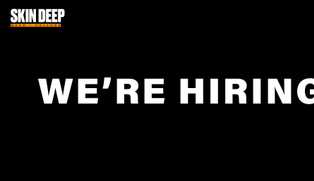BBZ’s Alternative Graduate show opened at the Copeland Gallery in Peckham last Wednesday, featuring ten early career artists practising in a range of mediums. The BBZ Collective, run for and by queer black women and non-binary people, opened their doors to Skin Deep a day ahead of the show to give us some insight on its history and mission.
As I walk into the Copeland gallery on a late August afternoon, Tia Simon-Campbell is organising a task over the phone while typing something up on her laptop, Naeem Davis is a in a full white protective jumpsuit, readying to continue painting a wall for an installation, and curator Deborah Joyce Holman is deciding which set of gold rings will best hold up a wall-wide painting. A busy production team is hard at work at a set of desks and each artist adds final touches to their installations, assisting each other in the process. Everyone is focused, precise, and strikingly present.
“We started conceptualising in January,” Davis, tells me during a quick break. “In March, we began putting things into place: the call out, finding a markeing team, getting a [producing] collective together. If I’m honest babe, it’s chaos, Davis laughs, “Absolute chaos.”
The space buzzes with a determined energy, and it is as if am witnessing the inside of a well-oil engine. It feels like anything but chaos.
Holman, who is a Ghanaian-Swiss artist and curator, worked with BBZ to curate the show. She walks me through the gallery space, spending some time at each piece to talk about the artist, about the intracacies within their work, and the various practices and intentions that ultimately came together to build an alternative to the art school norm.
“Let me start at the selection process. There was an open call and BBZ and I, alongside a panel of artists, selected ten emerging artists to showcase. The panellists this year were Ain Bailey, who works a lot with sound, Phoebe Collings James, who works with video and performance, Jamila Johnson Small, Last Years Interesting Negro, Lynnete Yiadom-Boakye the painter, and Travis Alabanza, who is a performer. The artists we chose were brought together because they are queer, they identify as women, as nonbinary people, as trans people, and are of black ancestry, so identity was a large factor. But what I really enjoy about this constellation of artists is that what they’ve presented is not at all monolithic or flat.”
There are so many textures to this show. It is refreshing and deeply satisfying to see a space built to hold the expansive talent and potential of black queer and trans artists. It is extremely satiating. I wanted to learn a bit more about the history behind the Alternative Graduate Show and why it felt like an important project for Davis and Simon-Campbell to devote so much of their time to. Now in its second year, BBZ have approached the show with a stronger and clearer set of processes, they have a dedicated and trustworthy team, and they continue to build a clearer vision of what the show could and should be.
“Last year we didn’t have any funding [when we announced,]” Davis tells me. “We just announced it, and had three month to make £20K.”
This year, the collective had a longer preparation schedule, secured early brand sponsorship, and then a grant from the Arts Council. They were also very intentional about building a curatorial process that considered each artist in context, accounting for factors that are not always given the full weight of their impact in calculations of artistic merit and success.
“We’re constantly trying to deconstruct the ways in which we put these together. And the reasons for it,” Davis says. “Every now and again we’ll make a decision and be like no that’s too parrallel to the ways in which institutions work.”
“We’re just tryna unlearn,” Simon-Campbell adds, “We’ve been so institutionalised.”
I ask her how the team went about implementing the changes they identified as necessary.
“At the forefront of our minds from last year was access. Who has access to being able to write a bio, to the materials that let them create the work they envision. That’s why this year we opened it up to people who hadn’t been to university. We also made sure we considered colourism and class privileges. We looked at these factors alongside the work.”
Much of the impulse behind this intentional curatorial process is also central to BBZ’s inception.
“BBZ started out of a very selfish need between myself and Tia. We felt very lonely, and like our artist practices weren’t being put to use because we felt alienated by our industries. And then when we thought about starting the party, because we both worked in nightlife, we knew we had to include art. Maybe not ours [Davis made films and Simon-Campbell photography], because we’d been so disillusioned by the powers that be, but facilitating other people’s work.”
BBZ aims to create a platform that serves and centres black queer and trans artists in the ways the industry didn’t. When Davis and Simon-Campbell were two years into the party, and institutions had proven themselves to be destabilising forces to their mission, the duo decided they needed an independent project. After a talk at the Royal Academy of Art, where a black student confessed they weren’t looking forward to their graduate show, BBZ decided they could create the alternative.
“We went to our housemates, [Imani Robinson and Rabz Lansiquot of former collective sorryyoufeeluncomfortable], and asked how they would feel about putting on a show, because we couldn’t do it by ourselves,” Davis says. “They said yes and were part of AGS last year. The rest is history.”
As we walk through the show with Holman, I stop and talk to a few of the artists. One such artist is Miranda Forrester, whose work explores the queer black female gaze in painting, and addresses the invisibility of womxn of colour in the history of art.
“[My installation features] work from two series. One is Our Naked Truths, a series of paintings from life drawing sessions held as art therapy for women of colour by a Camden collective. The model, always a woman of colour, would talk about their self-acceptance journey and relationship with their body, so it would be more intimate than mainstream life drawing class. And the other series is called Closed Doors, exploring queer couples and relationships in interior spaces and domestic settings. Going outside and accessing certain public spaces might come with a certain level of fear when you’re visibly queer, but when you’re in your own home, its sacred space and that makes it more intimate.”
Forrester’s paintings at once relay a textrue and lightness I haven’t seen before. Her work creates the illusion of space, of so much space and air for black women to take up and breathe. I ask Forrester how they consider their work within and amongst the larger landscape within her practice.
“My work is about reinventing the language of life drawing, and the whole idea of painting naked female bodies. What is it for me to do that, when the whole history of western art has been straight white male painters painting women for male consumption? How is it different if I’m painting these bodies? I situate myself in the female nude category, but I’m trying to do that differently. I’m examining how existing in my body makes portraying these images different.”
I also spoke to Kumbirai Makumbe, whose work, Volatile Landscapes, is a digital tryptic.
“A triptych is a painting that’s done in three parts,” Makumbe tells me. “I come from a design background, so my work is usually very digital. One of the works in this an interactive experience, and the other two are moving image digital works.
Makumbe’s work exists on three adjacent screens, one of which is connected to headphones for audiences who choose to engage more deeply with the work. I ask them how the three screens, each part of the tryptic, are connected.
“For the past two years I’ve been exploring blackness. I’m always opposing this idea of blackness being perceived as one dimension, because blackness should be able to exist in all its various forms. If you’re a designer you’re a form giver, meaning you get some stuff and it’s your job to make that stuff look good, or to decide how exactly someone is going to take that stuff in. A lot of my work is research-based, and I started thinking about how reseatch doesn’t have to just be presented on paper or in a book, it can be an experience and it can be audio-visual. And that’s what this piece is. This work also explores care; there are some black people who aren’t being cared for in the way that they should be by the people that should care. Like right now in our community there are a lot of black trans women being killed, and reposting something on insta isn’t going to do much. So there’s this whole aspect of the work explores caring and how, if we actually activate it, it could be super super powerful.”
***
“It works in two ways,” Holman tells me as we finish up my tour of the work. “Obviously, [a show like this] creates a space for all of us. But it also puts pressure on instituions to step up. This was all organised by BBZ. All the artists get artist fees. We’re doing it properly.”
“I’m just really happy we’ve managed to do it again,” Simon-Campbell says as we finish up. “It’s really hard. It’s really, really, really hard work and I think people think we have more access to money and support from brands than what we actually do. They don’t understand how much of our personal time energy money goes into creating this space.”
“It’s a labour of love,” Davis adds, “one that we’d like to keep doing, but doing it the right way. Last year, the burn out was real.”
It is far too normal, and almost expected, that black queer and trans artists stretch themselves thin. Before I leave, I ask Davis and Simon-Campbell whether they’ve put anything specific in place to make sure that burn out doesn’t again.
“It’s very different this year,” Simon-Campbell answers. “The BBZ Collective has grown and that means we have people dedicated to certain roles.”
“And we put stipulations in place between us personally,” Davis chimes. “Like: if this does not happen, we’re not doing it. We are making sure we’re being is taken care of.”
“It’s still been stressful! But nowhere near last year.”
“Far more enjoyable.”
As it should be.
The BBZ Alternative Graduate Show is open at the Copeland Gallery until 31st August, 12-19h Weds – Fri, 10-19h Sat & Sun. Suggested donation is £5.


%20%E2%80%93%20Danielle%20Brathwaite-Shirley.%20Video%20Still.%20BBZ%20BLK%20BK%20Alternative%20Graduate%20Show%202019.%20Copeland%20Gallery%2C%20London.%20Courtesy%20of%20the%20artist.png)

%20%E2%80%93%20Kumbirai%20Makumbe.%20Video%20Still.%20BBZ%20BLK%20BK%20Alternative%20Graduate%20Show%202019.%20Copeland%20Gallery%2C%20London.%20Courtesy%20of%20the%20artist.png)
%20%E2%80%93%20Miranda%20Forrester.%20BBZ%20BLK%20BK%20Alternative%20Graduate%20Show%202019.%20Copeland%20Gallery%2C%20London.%20Photo%20by%20Katarzyna%20Perlak.%20Courtesy%20of%20BBZ.jpg)
%20%E2%80%93%20Kumbirai%20Makumbe.%20BBZ%20BLK%20BK%20Alternative%20Graduate%20Show%202019.%20Copeland%20Gallery%2C%20London.%20Photo%20by%20Katarzyna%20Perlak.%20Courtesy%20of%20BBZ.jpg)

